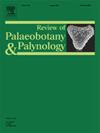Middle Devonian chitinozoan assemblages of northwestern Argentina and southern Bolivia: New biostratigraphic and palaeogeographical insights
IF 1.7
3区 地球科学
Q2 PALEONTOLOGY
引用次数: 0
Abstract
Chitinozoans from the Middle Devonian Los Monos Formation in the Tarija Basin (southern Bolivia and northwestern Argentina) have been analysed from the Tacobo TCB X-1001 (TCB-1001) and Ramos R-1011 (R-1011) boreholes. While the chitinozoan assemblages from the TCB-1001 borehole have been previously published, this contribution presents a comprehensive new analysis of the R-1011 material and integrates it into a refined biostratigraphic and palaeogeographical framework. Thirty-eight cutting samples were processed, yielding specimens in eighteen samples that allowed for taxonomic classification. A total of 11 genera and 40 species of chitinozoans were identified from both boreholes. Twenty species were identified in the R-1011 borehole, including the newly described species Lagenochitina postpirum n. sp. and Ramochitina durandi n. sp. Based on an integrated biostratigraphic analysis, three local chitinozoan biozones are proposed: the late Eifelian-early Givetian Ramochitina candelariaensis–stiphrospinata Biozone, the early Givetian Ancyrochitina flexuosa–Ramochitina ramosi Biozone, and the middle Givetian Ancyrochitina cornigera–Ramochitina autasmirimense Biozone. A palaeogeographical analysis using similarity indices indicates that there were no geographic barriers within the Tarija Basin and suggests interconnections among all Western Gondwana basins. However, the results for other palaeocontinents suggest that the Western Gondwana chitinozoan fauna did not mix with other faunas worldwide.
阿根廷西北部和玻利维亚南部的中泥盆世几丁虫组合:新的生物地层和古地理见解
利用Tacobo TCB X-1001 (TCB-1001)和Ramos R-1011 (R-1011)井对塔里亚盆地(玻利维亚南部和阿根廷西北部)中泥盆世Los Monos组的几丁虫进行了分析。虽然TCB-1001钻孔的几丁质动物组合已经发表,但这一贡献对R-1011材料进行了全面的新分析,并将其整合到精细的生物地层和古地理框架中。对38个切割样品进行了处理,其中18个样品可以进行分类。两钻孔共鉴定出几丁质动物11属40种。在R-1011钻孔共鉴定出20种,其中包括新发现的Lagenochitina postpirum n. sp和Ramochitina durandi n. sp。通过综合生物地层分析,提出了3个局部几丁虫生物带:eifelia晚期- Givetian早期Ramochitina candelariaensis-stiphrospinata生物带、Givetian早期antirochitina flexusa - Ramochitina ramosi生物带和middle Givetian acyrochitina cornigera - raochitina autasmirimense生物带。古地理相似性分析表明,塔里贾盆地内部不存在地理障碍,并表明西冈瓦纳盆地之间存在相互联系。然而,其他古大陆的结果表明,西冈瓦纳几丁虫动物群并没有与世界范围内的其他动物群混合在一起。
本文章由计算机程序翻译,如有差异,请以英文原文为准。
求助全文
约1分钟内获得全文
求助全文
来源期刊
CiteScore
3.50
自引率
21.10%
发文量
149
审稿时长
6 months
期刊介绍:
The Review of Palaeobotany and Palynology is an international journal for articles in all fields of palaeobotany and palynology dealing with all groups, ranging from marine palynomorphs to higher land plants. Original contributions and comprehensive review papers should appeal to an international audience. Typical topics include but are not restricted to systematics, evolution, palaeobiology, palaeoecology, biostratigraphy, biochronology, palaeoclimatology, paleogeography, taphonomy, palaeoenvironmental reconstructions, vegetation history, and practical applications of palaeobotany and palynology, e.g. in coal and petroleum geology and archaeology. The journal especially encourages the publication of articles in which palaeobotany and palynology are applied for solving fundamental geological and biological problems as well as innovative and interdisciplinary approaches.

 求助内容:
求助内容: 应助结果提醒方式:
应助结果提醒方式:


